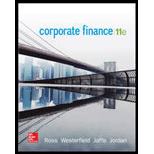
a)
Case summary:
SP is a real estate firm that was established by the present CEO, RS, 25 years ago. The company had been profitable for the past 18 years. Before commencing the real estate business, RS was involved in a bankruptcy of a farming business. SP has a plan to buy a tract of land in U Country for $45 million. This land will be leased to tenant farmers. The land purchase will raise the annual pre-tax earnings by $10 million in perpetuity.
KM, the new CFO, has been put in charge of the current project. KM has determined that the firm’s cost of capital is 10.5%. KM feels that the firm should issue debts to finance the project. Based on some planning, KM thinks that the company can issue bonds at par value with a coupon rate of 7%; she also believes that the firm’s capital structure in the range of 70% equity and 30% would be optimistic. The firm has to bear 40% corporate tax rate.
To determine: The
a)
Explanation of Solution
Calculate the net
After purchase, the company’s pre-tax earnings will raise by $10,000,000 per year in perpetuity. The tax rate is 40%.
Determine the earnings increase:
Therefore, the earning increase is $6,000,000.
As SP is an all equity company, the suitable discount rate is the company’s unlevered rate of equity. So, the net present value of the purchase is:
Net present value (NPV):
Therefore, the net present value is $12,142,857.
b)
To construct: The
b)
Explanation of Solution
After the announcement, the worth of SP’s business will raise by $12,142,857, the net present value of the purchase. According to the
Calculate the equity value of the firm:
The total debt and equity value of the firm is $533,500,000 and the net present value of the firm is $12,142,857.
Therefore, the equity value f the firm is $521,357,143.
The balance sheet after the land purchase as follows:
| Market value Balance Sheet | ||||
| SP Real Estate Company | ||||
| Assets | Liabilities | |||
| Particulars | Amount | Particulars | Amount | |
| Old Assets | $533,500,000 | Equity | $545,642,857 | |
| NPV | $12,142,857 | |||
| Total assets | $545,642,857 | Debt and equity | $545,642,857 | |
As the market value of the company’s equity is $545,642,857and the company has 11,000,000 shares of common stock outstanding, SP’s stock price after the announcement will be as follows:
Calculate the new share price:
Therefore, the new share price value is $49.60.
As SP must raise $45,000,000 to finance the purchase and the company’s stock is worth $49.60 per share.
Calculate the number of shares to be issued:
Therefore, SP should issue 907,187 shares.
c)
To construct: SP’s market value balance sheet after announcement that the company will finance the purchase using equity. Also, to determine how many shares of common stock does SP have outstanding and the price of share.
c)
Explanation of Solution
Explanation:
Create the market value balance sheet:
SP will receive $45,000,000 in cash as the effect of equity issue. This will raise the company’s assets and assets by $45,000,000.
The new market value balance sheet after the stock issue will be as follows:
Construct the balance sheet before the land purchase as follows:
| Market value Balance Sheet | ||||
| SP Real Estate Company | ||||
| Assets | Liabilities | |||
| Particulars | Amount | Particulars | Amount | |
| Cash | $45,000,000 | Equity | $590,642,857 | |
| Old Assets | $533,500,000 | |||
| NPV | $12,142,857 | |||
| Total assets | $590,642,857 | Debt and equity | $590,642,857 | |
The stock price will remain unchanged.
Calculate the total share outstanding:
The common stock value is 11million shares, and the shares to issue are 907,187.
Therefore, the total shares outstanding are 11,907,187.
Calculate the share price:
Therefore, the share price value is $49.60.
d)
To determine: SP’s market value balance sheet after the purchase has been made.
d)
Explanation of Solution
The project is expected to generate $10,000,000 of extra annual pre-tax earnings everlastingly. These earnings will be taxed at a rate of 40%. After taxes, the project raises the annual earnings of the company by $6,000,000.
Calculate the after-tax present value of the earnings increase:
Therefore, the after-tax present value of the earnings increase is $7,142,857.
Construct the balance sheet of the company:
| Market value Balance Sheet | ||||
| SP Real Estate Company | ||||
| Assets | Liabilities | |||
| Particulars | Amount | Particulars | Amount | |
| Old Assets | $533,500,000 | Equity | $590,642,857 | |
| PV of project | $57,142,857 | |||
| Total assets | $590,642,857 | Debt and equity | $590,642,857 | |
Want to see more full solutions like this?
Chapter 16 Solutions
Corporate Finance (The Mcgraw-hill/Irwin Series in Finance, Insurance, and Real Estate)
 Financial Accounting: The Impact on Decision Make...AccountingISBN:9781305654174Author:Gary A. Porter, Curtis L. NortonPublisher:Cengage Learning
Financial Accounting: The Impact on Decision Make...AccountingISBN:9781305654174Author:Gary A. Porter, Curtis L. NortonPublisher:Cengage Learning Intermediate Financial Management (MindTap Course...FinanceISBN:9781337395083Author:Eugene F. Brigham, Phillip R. DavesPublisher:Cengage Learning
Intermediate Financial Management (MindTap Course...FinanceISBN:9781337395083Author:Eugene F. Brigham, Phillip R. DavesPublisher:Cengage Learning





